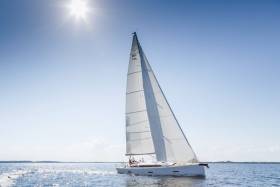Displaying items by tag: X49
X-Yachts returns to the Cannes Yachting Festival for 2022 with a bevvy of new and improved models on display from 6-11 September.
Experience the stylish power of the X-Power 33C — X-Yachts’ first foray into the powerboat market following its acquisition of HOC Yachts in late 2019 — at stand QSP141 in Cannes Vieux Port – Quai Saint Pierre.
And at stand Sail 197 in Cannes Port Canto, you’ll have the opportunity to jump onboard the Pure X flagship X5⁶, the family-friendly X4⁹ or the new-look X4³.

If you can’t make it to the south of France, you’ll have another chance to get up close with some of the newest additions to the X-Yachts range at the Southampton International Boat Show from 16 September.
‘Loose Screw to Blame’ for Rudder Failure on X-Yacht During ARC January
A loose grub screw was apparently the reason why a Dutch owner of an X-Yachts X4⁹ experienced rudder failure while taking part in a transatlantic cruising race.
During the ARC January race out of Gran Canaria last month, the rudder stock fell out of the top bearing on the affected vessel.
In addition to the loss of steering, the movement of the rudder stock damaged the GRP tube which encapsulates the bottom bearing and forms a water seal towards the inside of the boat.
The crew contacted X-Yachts Holland via satellite phone for guidance in resolving the issue. They were unsuccessful in their attempts to reinsert the rudder stock not the top bearing and were only able to partially secure the top in position.
While they managed to steady the water ingress to a level where the bilge pump could keep up, the crew feared a worsening situation and the next day chose to evacuate the boat and board two other yachts which were attending the race.
Two days after the evacuation, the boat’s insurance company entered with a salvage company who found the boat afloat four days later via its tracker. The generator had stopped but the bilge pump was running and the water level in the boat was still below floorboard level.
The salvage crew got the rudder stock in place and secured in the top rudder bearing relatively quickly, and they had the leak repaired and the water pumped out, after which they could tow the boat towards Gran Canaria some 1,400 nautical miles away.
X-Yachts’ director of design and engineering Thomas Mielec, was ready to meet the boat in Gran Canaria and along with the salvage company and insurance company began a joint effort to identify the cause of the damage.
 Diagram showing the structure of the rudder stock on the X4⁹
Diagram showing the structure of the rudder stock on the X4⁹
“The crew from the boat took photos and video in their attempt to repair the rudder, and it appeared that the top bearing had separated, and the rudder stock had dropped down,” Mielec said.
“The rudder bearing union nut, which holds the bearing together, had simply turned off the thread at the bottom of the inner housing, and this meant that the rudder and rudder stock, which are otherwise fixed in the bearing, had dropped downwards and out of the bearing.
”This happened even though the locking screw was in place in the union nut, and that with only one impression mark, ie without traces or burrs, which could indicate that the union nut had been turned off with the locking screw engaged. The other parts of the bearing showed no signs of overload prior to the incident in general.”
X-Yachts says it is still too early to draw a conclusion of the definitive cause of the damage, but Mielec suggests two possible scenarios based on the facts and observations found, with the second assessed as most likely:
- If it is established that there is no trace of Loctite on the locking screw, one possible scenario is that, in error, the locking screw was never secured with Loctite during manufacture of the bearing, and that the screw, without being noticed, had loosened over a period of two years, permitting the nut to also unscrew over time.
- If tests show that there were traces of Loctite in an expected amount on the locking screw, the cause could be that the safety screw had been removed/loosened by mistake during service work, which was carried out in Spain in November.
X-Yachts notes that the locking screw in question is only intended to be operated during the manufacturing of the bearing itself, and it is not necessary/permitted to touch during either assembly or possibly disassembly of the rudder in the yacht.
Customise Your Own X49 With X-Yacht’s X-Configurator
X-Yachts customers and window-shoppers alike can now configure their own X49 thanks to a new online tool.
The X-Configurator provides all the customisable options available for one of the latest additions to X-Yacht’s luxury Pure X range — and one that was named Cruising World’s Best Full-Size Cruiser in its 2019 Boat of the Year awards.
Designed for easy crew handling in all conditions, the X49 is as suitable for short family sailing trips as it is to long-distance blue-water cruising, as Susan and David Carratt can attest — yet maintains the performance of a competitive racer.
X-Yachts recently revealed more details of its newest cruising yacht, the X40 — and the marque will be at the new South Coast Boat Show in Southampton from 17-19 May displaying a high-spec model of the popular X43.
























































